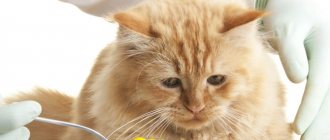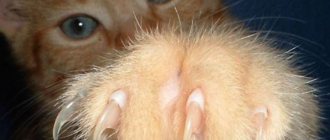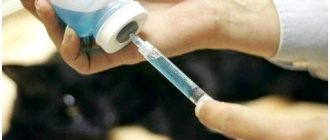Pain is a physiological reaction to certain disturbances in the normal functioning of the body’s vital systems. This is a signal to take action to help the pet. In some cases, feline pain medication should be given immediately.
In the article, in addition to drugs for pain relief, we also look at the causes of pain and give advice in which cases a cat really needs to be given medicine. We do not recommend skipping these sections, but if you want to know only about the best drugs and their prices, then refer to the contents .
Causes and symptoms
A number of pathologies in cats are accompanied by pain. It worsens the animal’s condition and its well-being. Negatively affects the pet's lifestyle. A cat may experience pain due to the following diseases:
- oncology;
- surgery and recovery period after it;
- injuries, damage to internal organs, ligament rupture, dislocations, bruises and fractures;
- renal failure in a chronic form of development;
- inflammatory processes of internal organs, this may be diseases of the pancreas (pancreatitis), disruption of the urinary system, otitis media and endometritis;
- peritonitis, as well as dilated stomach syndrome;
- colic both in the liver and in the liver;
- pathologies of the nervous system;
- toothache, especially when tooth enamel is destroyed.
What symptoms indicate pain? First of all, the cat's behavior changes. He becomes more aggressive and nervous. Anxiety appears. The pet begins to meow pitifully. When the disease begins to progress, apathy and lethargy are observed. The animal may hide in a corner and avoid all communication with the owner.
Pain syndrome may be indicated by loss of appetite, rapid pulse and rapid breathing. The pain is often accompanied by salivation and stiffness of movement. To relieve pain, the pet can take atypical positions.
The owner must pay attention to the animal’s unusual behavior in a timely manner and take timely measures. Is it possible to give cats painkillers on their own, without a veterinarian's prescription? The answer is negative. After all, many analgesics that are used to treat humans cannot be given to cats due to their high toxicity. The doctor will not only prescribe a suitable painkiller for the cat, but will also determine the correct dosage. If necessary, he will prescribe additional therapy.
What drugs are prohibited for cats?
How long does it take for a cat to recover from anesthesia after sterilization: how you can help
Some drugs that are used to treat people are prohibited from being used to treat pain in cats. The medications listed below cause stomach bleeding in pets and can cause their death.
A doctor must prescribe pain medication for a cat.
It is unacceptable to use drugs of the following type:
- Paracetamol;
- Analgina;
- Theraflu;
- No-shpy.
With great caution, only as prescribed by a veterinarian, you can use:
- Aspirin,
- Ibuprofen,
- Ketorol.
Types of painkillers
The doctor will determine what painkiller can be given to the cat during the appointment. All pain relief drugs used for animals are divided into two categories:
- Narcotic analgesics. These medications are classified as opioids. The drugs have a pronounced analgesic effect. They act directly on the central part of the nervous system. Affect pain syndrome located in the brain. They have sleeping pills and sedative properties. Capable of being addictive. They provoke the appearance of a number of negative phenomena.
- Non-narcotic drugs with analgesic effect. This group includes non-steroidal anti-inflammatory drugs. Some drugs in this category can also be used to treat humans. The drugs effectively relieve pain symptoms of moderate and mild severity. Widely used for inflammation in joints and muscle tissue. Involved in pathologies of the digestive system. They cope poorly with pain arising from injuries, fractures and in the postoperative period.
Homeopathic medicines can be used to relieve pain in a pet.
In addition to analgesics, animals can be prescribed antispasmodic drugs, antipyretic and anti-inflammatory drugs, antipsychotics and other drugs. Sometimes a topical pain reliever is prescribed for the cat.
Signs of pain in cats
Cats are very patient creatures and are less likely than dogs to show that they are in pain. Most often, the cat hides in a corner and silently endures the pain, openly expressing its suffering only on the verge of painful shock. The owner must be able to understand his pet in order to come to the rescue on time in a critical situation.
Symptoms of pain in a cat can include:
- an increase, or, conversely, a decrease in normal activity;
- attempts to avoid contact with a person, even to the point of displaying aggressiveness;
- loss of appetite;
- an unusual position that the animal takes in an attempt to relieve discomfort;
- restricted movements;
- constant change of place;
- salivation;
- rapid breathing and pulse.
Narcotic analgesics
Whenever a pet experiences pain, any owner thinks about what painkiller can be given to the cat. In fact, there are not so many means that can be used to treat animals. And medications used for people, dogs and other pets are not always suitable for cats.
Narcotic painkillers for cats can be of either natural or synthetic origin. Such drugs are used in the most extreme cases, as they provoke serious side effects and can be addictive. These drugs cannot be purchased at a veterinary pharmacy. They are purchased in a regular pharmacy for people and only with a doctor's prescription.
The following narcotic analgesics are considered adapted for cats:
- "Tramadol". The active ingredient is tramadol hydrochloride. The drug is used at a rate of 4 mg/kg. The break between taking the medicine and injections is 6-8 hours. This is an approximate dosage that may vary depending on the disease. Therapy lasts no more than five days.
- "Fentanyl." The active ingredient is fentanyl. The medicine is administered once every 48-72 hours. A dosage of 5 mg is taken per 450 grams of pet weight. The drug is addictive, so it should not be used for a long time.
Opioid medications are used for severe pain caused by injuries and tumors. The drugs are produced in the form of tablets, injections, capsules and drops. They can only be purchased with a prescription. Medicines provoke the appearance of such negative phenomena as vomiting, diarrhea and drowsiness.
The price of ten 2 ml Tramadol ampoules is 200 rubles. Five ampoules of the drug “Fentanyl” can be purchased for 50 rubles. Fentanyl patches are made for external pain relief.
Often cats are prescribed the drug "Omnopon". It belongs to narcotic painkillers. Contains morphine, papaverine, noscapine, codeine and thebaine. The daily dosage is 0.01-0.02 g, depending on the weight of the pet. The medicine remains effective for five hours. The drug is indicated for severe pain that occurs due to injuries and due to the onset of oncology.
An overdose of the drug can cause muscle weakness, gag reflex, drowsiness and respiratory depression. The drug is produced in ampoules for injection. The solution can have 1% and 2% concentration of the active substance. Available only by prescription.
Codeine is another narcotic analgesic that is used to treat pain in cats. The drug is a derivative of the opioid methylmorphine. The drug is not as effective as the above medications. Therefore, they only relieve pain of moderate severity. The daily dosage is 0.01-0.05 g. The daily dose is divided into several doses. Depends on the body weight of the animal. Side effects include constipation, retardation and vomiting. The drug is produced in the form of tablets and injection solution. The price of ten pills varies around 50 rubles.
If the veterinarian prescribed a narcotic pain reliever to your cat, then in order to avoid stomach irritation, it is better to choose the injection form of administering the drug.
Traditional and alternative methods
Mating cats: how long does sexual intercourse last and when can you mate?
If your pet is suffering from severe pain, you should not give preference to traditional methods of therapy. They are most often ineffective. Alternative methods of pain relief can be used only in cases of moderate severity.
In some cases, massage can relieve pain
It is very important to take the animal to an appointment with a veterinarian at the first sign of pain, who will determine the cause of the illness and prescribe the necessary medications. For mild manifestations of pain, an infusion prepared with chamomile, mint and lemon balm can help. The folk remedy helps to relax your pet and relieve pain.
To alleviate the animal’s suffering, you can use alternative methods of relieving pain, namely:
- Homeopathic remedies such as Traumatin, Traumeel. Medicines are made on a plant basis. They can only relieve mild pain. The duration of therapy exceeds 7 days. Quite often, Travmatin is used after castration of cats to relieve discomfort that causes anxiety to the animal.
- Manual therapy - massage. The procedures help improve blood circulation, relieve swelling, muscle spasms, and pain that arise from injuries.
- Compresses and heating pads used in the treatment of chronic diseases accompanied by pain and inflammation. With their help, you can effectively eliminate swelling.
- Acupuncture - acupuncture. The procedure helps relieve mild to moderate pain.
- Magnetotherapy, which helps eliminate pain and inflammation in the body.
Before deciding which way to relieve pain in a cat, it is necessary to identify the cause against which the syndrome developed.
NSAIDs for cats
Non-steroidal anti-inflammatory painkillers for cats not only relieve pain, but also eliminate inflammation. Not addictive. Among them, the most popular drugs are:
- "Ketofen". The painkiller belongs to the group of carboxylic acids. The medication is produced both in the form of tablets and in ampoules for injection. Active ingredient: ketaprofen. It is administered to cats subcutaneously at a dosage of 2 mg/kg. Only once a day, for three days. The drug is used for problems of the musculoskeletal system. It is prescribed for injuries. For external use, gels and ointments containing ketaprofen are produced. Ten tablets cost around 450 rubles. The drug is well tolerated by animals and causes virtually no side effects. The exception is an allergy to the components of the medication.
- "Ketonal". The active ingredient is ketoprofen. It is produced in the form of tablets, injection solution and gel. It is a strong pain reliever. It is prescribed to cats in injection form. He is pricked in the withers once a day. Dosage 1 mg/kg. Used for mild to moderate pain, after injuries and operations. The price of 10 ampoules is 200 rubles.
- Meloxicam. It has both analgesic and anti-inflammatory moderate effects. It is given to cats for bone disease, as well as for injuries and after operations. Side effects include allergies and digestive upset. The active ingredient is meloxicam. On the first day the animal is injected with 0.1 mg/kg, in the next 0.05/kg. The drug can be used in the form of a suspension, which is mixed with food. On the first day, give 0.2 mg/kg, then give at a dose of 0.1 mg/kg. Therapeutic course – 10 days. Three ampoules of Meloxicam cost around 200 rubles. The suspension is produced under the name "Loxicom". Its cost is 1000 rubles.
- "Rimadyl." The active substance is carprofen. It is produced both in the form of tablets and injections. It can be prescribed not only to relieve pain, but also to eliminate swelling and inflammation. Indicated for injuries and diseases of the musculoskeletal system. The medication is well tolerated by cats. The drug is given in a dose of 2 mg/1 kg. For a pet weighing more than 5 kg, use ½ tablet with a dosage of 20 mg. The waste rate is divided into two doses. After a week, the therapeutic dosage is reduced by half. The course of treatment is determined by the veterinarian. Twenty tablets cost around 500 rubles.
- "Vetalgin". The drug has a wide spectrum of action. It contains two active components: diclofenac sodium and drotaverine hydrochloride. Indicated for urolithiasis, as well as for spasms of the muscles of the gastrointestinal apparatus. It is also used for diseases of the joints and bones. Treatment of cats is carried out at the rate of one tablet per kilogram of the pet’s weight. The duration of treatment lasts from five to seven days. Ten Vetalgin tablets cost about 50 rubles.
What else can you do to numb a cat? The approved drugs include Baralgin, Amidopyrine, Papaverine, Butadione, Aspirin, Antipyrin, Salicylamide, Dexafort, Analgivet, Flexoprofen, Vetalgin. When treating a cat with these drugs, you should not rely on the dosage indicated in the instructions. It is approximate. A more accurate single and daily dose is prescribed by a veterinarian after a thorough assessment of the animal’s condition.
NSAIDs should only be given to your cat after meals, as they severely irritate the stomach lining. Often, the same medications are used to treat cats as for humans. Most often they are used in dosages intended for children under three years of age.
Diphenhydramine dosage for cats
Veterinarians note that allergies in cats are not such a rare occurrence. An animal can react to pollen, plants, various fabrics, plastic and rubber objects, food, food additives, dairy products, house dust, dust mites, flea bites, and household chemicals.
Antihistamines for cats, originally created for humans, are used to treat many types of allergies. Experts have developed a technique that includes their use in combination with fatty acids and an evasion method (eliminating possible allergens).
Content
Each antihistamine has a different dose and can cause different side effects, so they must be prescribed by a veterinarian. It is also not recommended to use H2 blockers, for example, Claritin, Hismanal, which are very effective for humans, but useless for treating cats. Doctors advise using medications containing H1 blockers. These include:
- 1st generation antihistamines (diphenhydramine, tavegil, donormyl, dimenhydrinate, diazolin, bicarfen, pipolfen, teralen), which have a pronounced sedative effect and a short duration of action.
- Antihistamines of the 2nd generation (astemizole, fenistil, tinset, terfenadine, claritin, kestin, soventol), among the side effects, have a cardiotoxic effect.
- 3rd generation antihistamines (cetirizine, fexofenadine), which have a more selective effect on histamine receptors, a longer duration of action, do not depress the nervous system.
Diphenhydramine
It has an antihistamine, sedative, hypnotic and analgesic effect. The dosage of the drug is strictly individual; at the same dose, it causes sleep in some animals, in others there is no sedative effect, and in a certain group it can provoke a state close to delirium. The drug is available in capsules and tablets.
Diphenhydramine
An effective antihistamine for allergic reactions and insect bites.
Has a sedative effect. It is an analogue of diphenhydramine, available in capsules of 25 and 50 mg. Not used to treat allergies in pregnant and lactating animals. It is also undesirable to combine it with taking antipyretic and cold medications.
For one kilogram of animal weight, 1-4 mg of the drug is needed, which is taken after 8-12 hours and is not mixed with food.
Hydroxyzine
It has an antihistamine, sedative, psychotropic, antiemetic effect. It belongs to piperazine derivatives, weakens skeletal smooth muscles, has a bronchodilator and analgesic effect. Not addictive.
Chlorpheniramine
The drug is for injection, the main active ingredient is 1% chlorpheniramine maleate. Used to treat allergic dermatitis and urticaria in cats. It is administered only intramuscularly; if it comes into contact with the skin, it may cause irritation.
Simultaneous administration during or after feeding reduces the irritant effect on the gastrointestinal tract. It is forbidden to combine with alkaloids.
The drug is only suitable for relieving acute symptoms and should not be used for more than 3 days.
Clemastine, tavegil
Relieves allergy symptoms in animals: eye irritation, runny nose, sneezing. It has a long-lasting effect by blocking histamine receptors. Side effects: thirst, hyperactivity or, conversely, apathy, diarrhea. Strengthens the effect of sedatives; combination with other drugs is undesirable.
It is used regardless of the weight of the animal, 1/2 tablet every 12 hours.
It combines a strong antiserotonin substance with antihistamine activity, which is why it is effective for itchy dermatitis. Relaxes the muscles of the bronchi. Causes a side effect in the form of increased appetite.
Pipolzin
The active ingredient is promethazine hydrochloride. Antagonist of histamine H1 receptors. Available in the form of an injection solution, it is used to relieve allergy symptoms. It acts longer than diphenhydramine and produces a mild sedative effect. The dose is calculated depending on the weight of the animal.
Oncology in animals
Strong painkilling injections are given to cats for cancer. Tramadol is most often prescribed for this disease. It affects the spinal cord. Inhibits pain in the body, acts in the very center of the nervous system. The analgesic is very strong and can cause many side effects in the cat. Used only in cases of extreme necessity.
To alleviate the condition of a cat with malignant tumors, they also give Fentanyl. It can be prescribed either as tablets for oral administration or as injections. The fentanyl patch is less toxic.
All narcotic analgesics are used only for health reasons. Only a doctor can prescribe them. They are highly addictive, so when taken for a long time, these drugs need to be changed from time to time. Periodically you need to increase the dose.
NSAIDs are also used for oncology. These medications do not have the same pain-relieving effect as opioids, but they are not addictive. Long-term therapy with these drugs is allowed. They are prescribed by veterinarians for moderate pain. But non-steroidal drugs are far from safe. They can negatively affect the health of the animal. Negatively affects the kidneys, liver organ and hematopoietic system. And you shouldn’t use them without a doctor’s prescription.
What to do in this situation? What should I give my cat? A narcotic painkiller or medications that are less harmful to the animal’s body? This issue can only be resolved by a specialist after examining the pet.
Harm and benefits of analgin for cats and can this drug be given to kittens
Experts do not give a clear answer to the question of whether cats can take Analgin. The fact is that taking the drug allows the animal to feel only temporary relief, but the causes of the malaise remain.
In addition, metamizole sodium poses a certain danger to animals, since cats are more sensitive to this chemical component than humans.
Giving Analgin to a kitten is strictly prohibited, since his body is not yet strong enough, and it is likely that he will not be able to cope with even the minimum dose of the drug. The consequences of exposure to Analgin in this case can be very serious, even fatal.
Analgin is strictly contraindicated for small kittens.
In most cases, specialists prescribe this drug when the expected benefit from its use is much greater than the potential risk.
Analgesics for toothache
What painkiller should I give my cat for toothache? If the oral cavity is injured, teeth are crumbling or pain, then the animal can be helped by using the following gels:
- "Traumatin."
- "Nibbler."
- "Metrogil Denta".
- "Strong teeth."
- "Dentavedin."
The inflammatory process in the oral cavity can be eliminated by treating the mucous membrane with a chlorhexidine solution several times a day. Whether a cat can take pain medication for a toothache or not, the doctor must decide. Although, if the pain is unbearable and causes discomfort to the pet, then you should use non-steroidal anti-inflammatory drugs, such as Meloxicam, Ketofen, Ketonal.
Characteristics of the drug
Also known as Metamizole, analgin is a fairly effective and inexpensive pain reliever. Note that metamizole sodium is the main component of tempalgin, baralgin and pentalgin. Theoretically, all these remedies can be given to pets, but only in cases where there are no more suitable medications within reach, and the cat urgently needs to relieve acute pain.
Analgin for animals is available in the form of powder, tablets and solution, sealed in ampoules. The taste is bitter, soluble in water (powder and solution). In addition to its analgesic ability, it reduces fever well and also has a rather weak anti-inflammatory effect. The latter is due to the fact that the drug can inhibit the synthesis of prostaglandins.
When administered orally, the painkiller begins to work in about 40 minutes; if administered intravenously, the analgesic effect appears almost immediately. Peak action is achieved after approximately two hours. Analgin acts similarly when administered intramuscularly. Regardless of the method of administration, it does not irritate local tissues.
Pain with pancreatitis
Is it possible to give cats pain medication for pancreatitis? Usually, with this disease, the pet experiences quite severe pain. To remove it, the animal may be prescribed the following treatment regimen:
- If the pain is tolerable, then veterinarians recommend Biprenorphine. Anesthetic for a cat is administered intravenously or intramuscularly. Single dose 0.005-0.015 mg/kg. The interval between injections is 4-8 hours.
- Severe pain is eliminated with Fentanyl. The drug is administered both intravenously and intramuscularly at a dose of 0.005-0.01 mg/kg. The medicine is given to the animal every two hours.
- In the most severe cases, Fentanyl is combined with Ketamine. Medicines are used in a dosage of 0.002-0.004 mg/kg and administered hourly.
To consolidate the result, in addition to analgesics, a fentanyl patch is prescribed. Its action lasts for 3-4 days. The veterinarian may additionally prescribe tablets such as:
- "Butorphanol". The dosage for a cat is 0.5-1 mg/kg. The drug is taken every 6-8 hours.
- "Tramadol". The norm for a cat is 4 mg/kg. The frequency of administration is every 12 hours.
Analgin-ultra
Local reactions: with intramuscular injection - infiltrates at the injection site.
Use with caution during pregnancy, especially in the first trimester and in the last 6 weeks.
Contraindicated in cases of severe liver dysfunction.
Contraindicated in cases of severe renal impairment.
Use with caution in children in the first 3 months of life.
Single doses for children aged 2-3 years are 50-100 mg; 4-5 years – 100-200 mg; 6-7 years – 200 mg; 8-14 years – 250-300 mg; frequency of administration – 2-3 times/day.
With long-term use, it is necessary to monitor the peripheral blood picture.
Metamizole sodium is used in combination with pitofenone and fenpiverinium bromide as an analgesic with an antispasmodic effect.
When used simultaneously with analgesics-antipyretics and NSAIDs, mutual enhancement of toxic effects is possible.
READ How long does a cat's memory last?
When used simultaneously with inducers of microsomal liver enzymes, the effectiveness of metamizole sodium may decrease.
When used simultaneously with phenothiazine derivatives, severe hyperthermia is possible; with sedatives, anxiolytics - the analgesic effect of metamizole sodium is enhanced; with tricyclic antidepressants, oral contraceptives, allopurinol - the metabolism of metamizole sodium is disrupted and its toxicity increases; with caffeine – the effect of metamizole sodium is enhanced; with cyclosporine – the concentration of cyclosporine in the blood plasma decreases.
When metamizole sodium is used in combination with pitofenone hydrochloride (has a direct myotropic effect on the smooth muscles of internal organs and causes its relaxation) and with fenpiverinium bromide (m-anticholinergic), their pharmacological action is mutually enhanced, which is accompanied by a decrease in pain, relaxation of smooth muscles and reduction of elevated body temperature.
Painkillers for cats with fractures, injuries and bruises
In case of a fracture, the cat is prescribed the most powerful analgesics, such as Tramadol and Fentanyl. In this situation, Ketonal, Rimadyl, Tolfedin and Ketofen will help relieve pain.
For mild to moderate injury, painkillers can be given to the cat in injections and tablets. The most popular medications are:
- "Baralgin";
- "Artrosan";
- "Pentalgin";
- "Papaverine".
In some cases, the cat is given Analgin with Diphenhydramine. The maximum dose of Analgin for a cat should not exceed 0.5 g.
If there are no ruptures or internal damage, then ordinary ice will ease the condition of dislocations and bruises. Additionally, pain-relieving patches such as Kefentek, Fentonyl and Ketonal are used.
For bruises in a cat, painkillers gels and sprays are used. They are characterized by analgesic and anti-inflammatory properties. Among them are “Travmagel”, “Safroderm-gel” and “Bio Groom spray”.
Is the drug beneficial or harmful?
Experts do not have a clear opinion on whether cats should be treated with Analgin. On the one hand, the substance does not have a significant therapeutic effect; it brings only short-term relief to the animal, leaving the causes of the ailment unchanged.
There is also concern about the increased sensitivity of cats to this drug. So, in principle, the use of Analgin is not recommended for small kittens, even in small quantities. Of course, the exception remains cases when, due to the lack of another drug, there is simply no alternative solution and you have to inject this particular drug.
Castration of a cat: painkillers
Castration, like sterilization, is a very unpleasant and painful procedure for a pet. At first the animal is depressed and loses its appetite. It is at this time, that is, in the first week after surgery, that the pet should be given analgesics. At the veterinary hospital, the doctor tells how to numb the cat. Most often the following medications are used for these purposes:
- Suspension "Loxicom". It is produced with different concentrations of the active substance: 0.5 and 1.5 mg/ml. On the first day after castration, 0.1 mg/kg is prescribed. On the second day, the cat is given 0.05 mg/kg.
- "Rimadyl." Produced in tablets of 20 and 50 mg. The pills taste like liver, so the animal eats them without difficulty. On the first day, a dosage of 4 mg/kg is given, after a week of treatment the dose is reduced to 2 mg/kg. A 20 mg tablet is designed for an animal weighing 5 kg.
- "Ketofen." A 1% solution is prescribed at a dosage of 0.2 ml/kg. The course lasts from one to three days.
- "Ketonal". For injection, 0.2 ml of the drug is diluted with 1 ml of saline solution. The resulting volume is calculated for an animal weighing 5 kg. Injections are given subcutaneously once a day.
The painkiller helps the cat recover. Improves his well-being and shortens the animal’s rehabilitation period.
How to use
Analgin and Diphenhydramine can be used for pain of any origin. In severe cases, it is administered intravenously, due to its faster and stronger action than tablets. If the animal is in severe pain and there is no veterinarian nearby, the drug is injected into the muscle.
Analgin injections or tablets are recommended for:
- Arthritis
- Arthrosis
- Bursitis
- Limb injuries
- Complications during childbirth
- Complex infections accompanied by pain and fever
According to experts, the medicine has shown itself quite well in diseases of the gastrointestinal tract, regardless of their etiology. It has proven effective in treating spasms and colic. Veterinarians also practice prescribing Analgin to cats and cats that have undergone sterilization, especially if the surgical intervention was accompanied by complications. If after surgery the cat feels unwell, has a fever or chills, Analgin will definitely improve its well-being.
Please note that even if you independently decide to give your pet Analgin, you still need to consult a veterinarian, since it also has certain contraindications.
Homeopathy
Both narcotic analgesics and non-steroidal anti-inflammatory drugs can not only alleviate the animal’s condition, but also cause serious side effects. Therefore, you should not resort to these medications unless necessary. And for moderate pain, the use of homeopathic medicines is allowed. The most common are:
- "Traumel". Produced in the form of a gel and injection solution. For injuries, the drug is given to the cat every 15 minutes during the first half of the day. Subsequently, the drug is used five drops every half hour. After 24 hours, the drug is used every two hours. The course of treatment is fourteen days. Before giving the medicine to the cat, the drops are diluted in water. Injections of this drug have a more pronounced effect. Adult pets are administered 1 ml once or twice a day. For kittens, a single dose is 0.5 ml.
- "Traumatin." Contains extracts of medicinal herbs and ASD-2. The drug is administered intramuscularly in a dose of 0.5-2 ml or given one tablet per day. Kittens are given ¼ tablet. The medicine is not addictive and can be used for a long time.
Medicines in this group not only relieve pain, but also treat. They help the animal recover and improve its health. They are considered the safest for cats.
What painkillers cats can use has been described in detail in this article. The final decision in treating the animal rests with the veterinarian.
Alternative ways to relieve a cat from pain
Acupuncture relieves pain from chronic diseases
- Magnetotherapy . Effectively eliminates the inflammatory process and reduces discomfort.
- Acupuncture . Helps with pain symptoms accompanying chronic diseases.
- Homeopathic medicines . They assume a long course and are not suitable for immediate relief of pain.
- Compresses . Relieves long-term pain. Eliminate traumatic swelling. Accelerate the healing of the wound surface.
- Massage . Kneads tissues, improves blood circulation. Relieves nagging pain from fractures.
To help your beloved pet you need to know the cause of the disease. Thoughtless use of medications will not only not help the cat, but will also increase suffering. Only a veterinarian is able to properly assess the situation and prescribe appropriate treatment.
Action
Analgin, which is also known as Metamizole sodium, is a fairly effective and at the same time inexpensive pain reliever. Instructions for use of Analgin for cats describe how and in what doses to give the animal the medicine. For animals, the product is available in the form :
- Powder
- Tablets
- Solution in ampoules
© shutterstock
It dissolves well in water, but has a rather noticeable bitter taste. In addition to the analgesic effect, it also has :
- Antipyretic properties
- Anti-inflammatory properties
If Analgin is administered orally to a cat after surgery, it begins to act in approximately 40 minutes. When administered intravenously, the effect of the drug is almost instantaneous. The peak effect of the drug is observed in the second hour after administration. Also with intramuscular administration. In any case, it is worth writing that no matter how you give the substance to the animal, it does not irritate its internal tissues and organs.
Dosage and Notes
Up to 0.5 grams of this medicine per day can be given to a cat orally. To do this, you have to grind the tablet very finely, since the taste of the drug is bitter, and you have to mask it in a large amount of minced meat or fish (or something equally tasty for your pet). What is the dosage of analgin for cats in case of parenteral administration?
Up to 0.2-0.3 ml of solution per animal is injected intramuscularly, but here everything depends on its physiological state, weight, age and other factors. Intravenous doses are the same as for intramuscular administration.
Attention! Giving your cat analgin constantly and daily is highly not recommended, since in this case there is a considerable probability of developing pathologies of the hematopoietic system.
Don't take risks! But you shouldn’t worry too much: nothing will happen to your cat from occasional use. It is worth considering that a newborn kitten should still choose a more gentle analgesic. The danger of metamizole is that with long-term (!) use it has a toxic effect on the red bone marrow.
Indications and methods of use
Can be used for pain reactions of any etiology. If the case is severe, the drug should only be administered intravenously, since oral use will not have any effect. In situations where there is no specialist nearby, and the cat needs help urgently, you can inject the drug intramuscularly. So, in what cases is its use most justified? Let's list them:
- Arthritis, arthrosis, bursitis, other diseases of the limbs.
- Dislocations and fractures.
- Various types of injuries, bruises.
- Difficult childbirth.
- Severe infectious diseases, accompanied by a strong increase in body temperature and severe pain reaction.
Experienced specialists also say that this medicine has proven itself to be effective for various gastrointestinal diseases, as it can quite effectively relieve spastic spasms and colic. You can give analgin after sterilization. This is especially true in cases where you have every suspicion that the operation was difficult. If your cat feels unwell, has a very high temperature and starts to feel chills, analgin can improve your pet’s condition. But! Immediately after its administration, you must contact a veterinarian, or take the animal to him yourself.
Can a cat be given painkillers intended for humans?
In most cases, cats are treated with painkillers intended for humans. However, drugs are used only after diagnosis and in doses prescribed by a veterinarian. It is especially dangerous to give your pet narcotic analgesics, which can cause respiratory arrest.
I tried never to treat pets without first consulting a doctor. It is impossible to determine the exact dosage at home, and some human medications for cats are very harmful. When a pet had urolithiasis, they gave him the medications prescribed by the veterinarian. Very soon the pain went away, and trips to the toilet became more productive. I do not recommend injecting animals with any analgesics or antispasmodics yourself.
Painkillers are sometimes the only way to relieve your pet of severe symptoms. Some of them have a mild and short-term effect, while others can eliminate unpleasant sensations for a long time. It is important to consult a doctor before giving your cat medication.
Results
The following narcotic drugs are popular among veterinarians for complex cases of pain relief in cats: morphine, codeine, fentanyl, tramadol, buprenorphine, omnopon. These drugs should be prescribed and taken only in clinics and subject to strict reporting.
Do not forget that all of the above drugs have their own sets of side effects. They cannot be used blindly. Before giving a coke an injection, tablet or gel, find out the cause of the pain from your veterinarian and begin comprehensive treatment.
If you urgently need to anesthetize your cat if it is injured in order to prevent the animal from dying from painful shock, use Loxicom and immediately contact a specialist. All other types of pain require finding out the cause and only then prescribing the drug.











